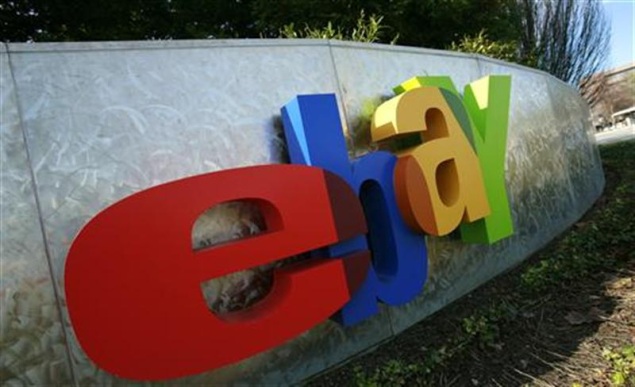- Home
- Internet
- Internet News
- EBay lures big retailers in Amazon battle
EBay lures big retailers in Amazon battle

EBay Chief Executive John Donahoe and other executives have been telling retailers that Amazon is their enemy, while eBay is a friend because, unlike Amazon, it holds no inventory.
Amazon buys products wholesale, stores them in inventory and sells them to consumers at higher prices like all retailers. EBay says it just matches buyers and sellers.
That message is sinking in, especially among brick and mortar retailers that are losing market share to Amazon.
"As retailers look for new vehicles for growth eBay becomes a natural partner a better partner than Amazon," said Sucharita Mulpuru, an e-commerce analyst at Forrester Research.
When RadioShack Corp reported a surprise quarterly loss last month, Chief Executive Jim Gooch told analysts that the electronics retailer had set up an eBay storefront to help the company reach new customers online.
Barnes & Noble, Toys "R" Us, GNC Holdings, Aeropostale and Neiman Marcus are among other big retailers that now have storefronts on eBay. Best Buy Co Inc sells mobile phones and wireless plans on eBay.
On Monday, eBay said it was testing a same-day delivery service called eBay Now with Target Corp, the second-largest U.S. retailer, and other big retailers including Macy's Inc, Nordstrom Inc and Walgreen Co. Amazon offers same-day delivery in some areas already.
The foundations of eBay Now rest on Milo, a start-up eBay acquired in late 2010 which lets merchants upload in-store inventory onto eBay's online marketplace. When shoppers search on eBay now, they see what online sellers are offering, but also which nearby physical stores carry the product.
More than 50,000 stores in the United States have uploaded inventory to eBay, via Milo, including major retailers Home Depot Inc, Ikea, Lowe's Companies Inc, Sears Holdings Corp and J.C. Penney Company Inc.
"It's simple: location, location, location," said Ben Schachter, an analyst at Macquarie. "Sellers have to go to where the buyers are."
EBay has more than 100 million active shoppers on its online marketplace, he noted.
"Retailers don't have those kinds of numbers coming to their sites and buying," Schachter said. "They would love to only sell through their own site, but they have to go where the buyers are, and many are on eBay."
'Worst-kept secret
Amazon has a lot more active customers about 180 million but some retailers steer clear still.
Barnes & Noble, which has been hammered by Amazon, has had an eBay storefront since late 2010 and mostly uses it to sell refurbished Nook gadgets. Toys and books were added in May 2011.
"EBay has been an exceptional partner, working with Barnes & Noble to effectively promote Nook to its massive user base," said Barnes & Noble spokeswoman Mary Ellen Keating. "Amazon is a competitor. We don't sell on Amazon and have no plans to do so."
Toys "R" Us does not sell on Amazon either. More than a decade ago, the largest toy retailer had exclusive rights to supply some toys on Amazon's website. That partnership ended in litigation and Amazon is now a leading toy retailer in its own right.
"It's the worst-kept secret in the retail industry," said Mulpuru. "When you partner with Amazon, they are looking at your data, learning your business and have ambition to get into every category."
Among the 100 largest retailers in the United States, most are choosing eBay over Amazon, according to Scot Wingo, chief executive of ChannelAdvisor, which helps merchants sell on both online marketplaces.
An Amazon spokesman declined to comment.
Amazon's marketplace for third-party sellers is growing rapidly and Wingo said that would not be happening if all retailers thought Amazon was the enemy.
The lure of Amazon's massive customer base is still powerful for many.
"We take any chance of getting new eyeballs and Amazon is just so large in the world of e-commerce," said Jerry Deboer, senior vice president of marketing at Jos. A. Bank, which has Amazon and eBay stores.
RadioShack also has both, and big retailers including Office Max and Sephora run Amazon stores.
Adding large sellers to eBay's marketplace helps the company in several ways.
EBay takes a cut of sales, so higher-volume sellers may help the company generate more revenue and profit.
EBay and retailers declined to discuss fees. However, eBay charges less for top sellers and negotiates individual deals with the biggest and best, according to Wingo.
EBay has struggled in the past because some of the products on its site were listed poorly or of questionable quality, and customer service from small sellers is not always what it could be. Big retailers are more likely to sell higher-quality products, categorize them more and provide better service.
Different shoppers
Retailers say eBay storefronts attract different shoppers than the ones who come to their own websites and physical stores.
EBay shoppers often search for deals, so some retailers use eBay to sell end-of-season or outlet products at lower prices.
Neiman Marcus' eBay storefront sells apparel, shoes and accessories under the Last Call brand, its outlet business.
EBay provides data to retailers to help them check if the shoppers who come to their eBay storefronts overlap with their existing customer base, according to Michael Jones, vice president of merchant development at eBay.
"By and large, people see this as a very significant incremental channel for them," Jones said.
In early 2010, eBay started including storefront inventory in results when shoppers searched on the website's front page. That has helped retailers place their products in front of more consumers, according to Jones.
Copyright Thomson Reuters 2012
Catch the latest from the Consumer Electronics Show on Gadgets 360, at our CES 2026 hub.
- Samsung Galaxy Unpacked 2025
- ChatGPT
- Redmi Note 14 Pro+
- iPhone 16
- Apple Vision Pro
- Oneplus 12
- OnePlus Nord CE 3 Lite 5G
- iPhone 13
- Xiaomi 14 Pro
- Oppo Find N3
- Tecno Spark Go (2023)
- Realme V30
- Best Phones Under 25000
- Samsung Galaxy S24 Series
- Cryptocurrency
- iQoo 12
- Samsung Galaxy S24 Ultra
- Giottus
- Samsung Galaxy Z Flip 5
- Apple 'Scary Fast'
- Housefull 5
- GoPro Hero 12 Black Review
- Invincible Season 2
- JioGlass
- HD Ready TV
- Laptop Under 50000
- Smartwatch Under 10000
- Latest Mobile Phones
- Compare Phones
- Honor Win RT
- Honor Win
- Xiaomi 17 Ultra Leica Edition
- Xiaomi 17 Ultra
- Huawei Nova 15
- Huawei Nova 15 Pro
- Huawei Nova 15 Ultra
- OnePlus 15R
- Asus ProArt P16
- MacBook Pro 14-inch (M5, 2025)
- OPPO Pad Air 5
- Huawei MatePad 11.5 (2026)
- Xiaomi Watch 5
- Huawei Watch 10th Anniversary Edition
- Acerpure Nitro Z Series 100-inch QLED TV
- Samsung 43 Inch LED Ultra HD (4K) Smart TV (UA43UE81AFULXL)
- Asus ROG Ally
- Nintendo Switch Lite
- Haier 1.6 Ton 5 Star Inverter Split AC (HSU19G-MZAID5BN-INV)
- Haier 1.6 Ton 5 Star Inverter Split AC (HSU19G-MZAIM5BN-INV)












